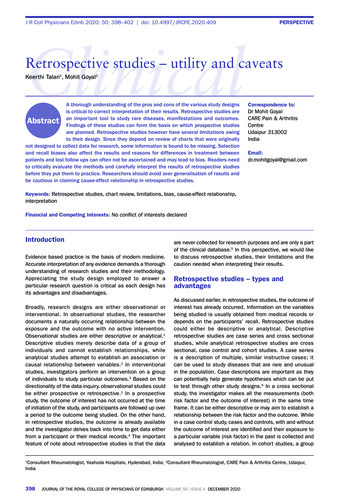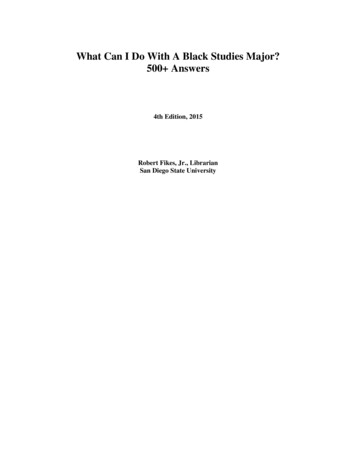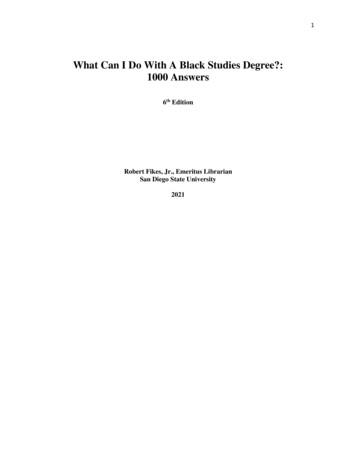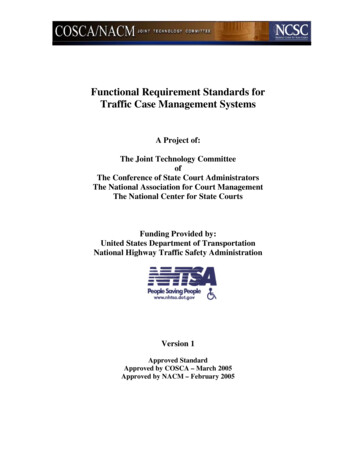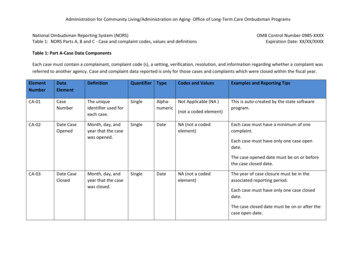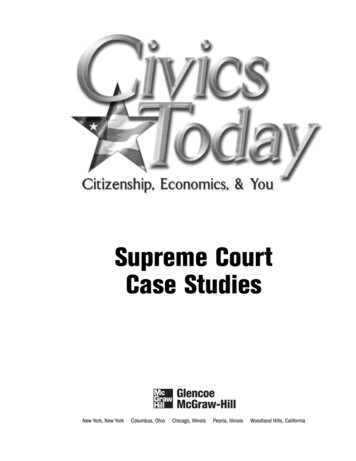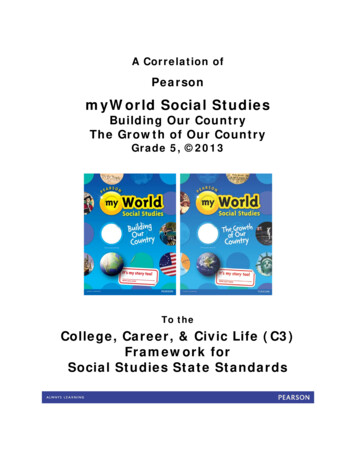
Transcription
Using Case Studies as a Scientific Method:Advantages and DisadvantagesLinnéa KrusenvikHalmstad University, Halmstad, SwedenAbstract: The case study as a scientific method is, and has been for a long time,a subject of heavy discussion in the scientific community. Some scientistsdisregard the study completely and argue that it’s nothing more than story-telling,while others claim that the case study is the most relevant research method thereis. As with all scientific methods case studies have both advantages anddisadvantages and the aim of this study is to present and discuss these.Keywords: case studies; scientific method; qualitative; in-depthIntroductionCope (2015) states that case study research is often described as a flexible but challengingmethodology that is most commonly used in social science research. Of all the social scienceresearch methods the case study has the least attention and support, due to its lack of welldefined protocol. Lindvall (2007) argues that the methodological criticism directed towardscase studies is also based on that the study cannot provide insights into causality and generalconditions. Even though the study is heavily criticized, the method has never lackedadvocates and a vast number of case studies are executed and published annually in scientificjournals.Case studies are said to be an intensive study, which is defined as an in-depth study of fewunits with multiple variables. The purpose of intensive studies is to get as complete a pictureas possible of a situation, a phenomenon or event (Jacobsen, 2002). In case studies, the focusis on one particular unit. These units can be of different kinds and they can be defined byboth space and time. A unit can be an individual, a group, an organization or a localcommunity. The use of case studies is suitable when we want to understand the interactionbetween a specific context and a phenomenon (Jacobsen, 2002).When it comes to the definition of a case study there are a few different suggestions. Awell-known and used definition comes from Yin (2009) who defines the case study researchmethod as:An empirical inquiry that investigates a contemporary phenomenon in depthand within its real-life context, especially when the boundaries betweenphenomenon and context are not clearly evident (p.18).Woodside (2010) uses a broader definition:
2Linnéa KrusenvikCase study research is an inquiry that focuses on describing, understanding,predicting and/or controlling the individual (p.1).Gerring (2004) argues that, even though, much of what we know about the empirical worldcomes from case studies and the fact that a large number of scientific work is generated bycase studies, the method is held in low regard. Verschuren (2003) means that one explanationfor this is that the status of the case study as a research method is not quite clear. Even thoughcase studies are common, there is a lack of clarity and no real consensus in what a case studyis about, how to concretely conduct that form of research and what results can be obtainedfrom it (Merriam, 1994). Gerring (2004) states that even many of the study’s defenders areconfused when it comes to the strengths and weaknesses of this ambiguous research method.He says that: “The case study survives in a curious methodological limbo” (p.341). Anotherexplanation of this unclear status is that the case study is often defined as the study of onesingle case, rather than as a way of doing research (Verschuren, 2003).Yin (2009) however, stresses that case studies have both advantages and disadvantages asa research method, and that it is important to understand and acknowledge that fact. Casestudy research, like all other research, complements the strengths and limitations of othertypes of research. Merriam (1994) agrees and mean that a researcher can choose from severaldifferent scientific approaches, that have their own way of illustrating something specialabout the phenomenon being studied. Whether or not to choose a case study or some otherapproach depends on what it is that the researcher is looking for and what questions theresearcher wants to answer. Reis (n.d.) says that the merits of a particular method depend onif it’s the most appropriate way of addressing the research problem that we are facing.BackgroundHistorically, case study research was marked by periods of use and disuse (Cronin, 2014). Inthe beginning of the 20th century the university of Columbia in the USA, started to criticizethe usage of case studies. They argued that case studies were too descriptive and qualitativeto be able to contribute to the scientific research and dismissed the results and findings aslacking validity and reliability (Solberg Søilen & Huber, 2009; Elman, Gerring & Mahoney,2007). The criticism received a lot of assent and the method was used to little extent, held inlow regard or simply ignored, for many years (Solberg Søilen & Huber, 2009).According to Merriam (2009) it wasn’t until the evolution of qualitative research methods,in the 1980’s, that case studies received attention from a methodological perspective. Elman,Gerring and Mahoney (2016) and Merriam (2009) all argue that today the case study hasgained a multitude of followers even though many scientists are still sceptical as to whetherthe study can be said to be of scientific value. The study is mainly viewed and used as aqualitative research method, even though it can also include quantitative analysis andhistorical data. Like all qualitative research the case study searches for meaning andunderstanding.
Case studies as a scientific method3MethodThis study is a literature review with the aim of attempting to answer what advantages anddisadvantages case studies have as a scientific method. The study exclusively uses secondarysources and is primarily based on previous scientific research in the form of scientific papers,published in several different journals. The papers were found in databases, mainly Web ofScience, and reference lists. Books relevant to the subject were also used, as well as a fewwebsites and case studies to get different perspectives on the subject. The different findingsand views on the subject in the literature provide the material for both the empiricalframework and the discussion and analysis in this paper.A qualitative method was used to gain and provide a deeper knowledge and understandingof the subject of case studies as a research method and its advantages and disadvantages.Literature reviewAs a research model the case study is used in many situations: to contribute to our knowledgeof individual, group, organizational, social, political, and related phenomena. The case studyis often used as a scientific method in social science disciplines such as psychology,sociology, anthropology, social work, business, education, nursing and community planning.They are even found in the field of economics. The goal is to design good case studies andcollect, present, analyse and report data in a fair way (Yin, 2009; Verschuren, 2003).Soy (1997) argues that the complexity of the case study comes from that they generallyinvolve several sources of data, may include multiple cases within a study, and produce a lotof data for analysis. Researchers use the method to build upon theory, to produce new theory,to dispute or challenge theory, to explain a situation, to explore or to describe a phenomenonor an object.Solberg Søilen and Huber (2009) states that case studies can be used for both descriptiveand empirical research. When used in descriptive research the case study describes a situationthat we have observed or been told about. The event has happened before we wrote it downand what is written doesn’t affect what happened. Neither have we been able to influencewhat happened. When case studies are used empirically they are used to start a roleplaybetween parties, and in that way gain understanding and describe their actions. We are partof what course of action is taken.Presented below are four different case studies that illustrate what case studies can be usedfor and how they can be designed and executed.Case 1.“Berglunds Mekaniska AB” (Solberg Søilen & Huber, 2004) is a descriptive case study of asmall company, in the metal industry, that is facing a lot of the typical problems found in thebranch. The case study tells us the story behind the company, how the business works andmainly focuses on its problems with the lack of clear leadership, lack of vision and plans for
4Linnéa Krusenvikthe future, and the defective communication with the employees. The study gives us a deepinsight into the company and its problems and how the company is trying to fix them.The study was made from oral interviews with the CEO of the company and a consultant,and from written sources such as the company webpage.Case 2.The second case study “Normative control in the pre-school: A Swedish case study”(Riddersporre, 2010) is part of a series of case studies in the project “Normative leadershipin the pre-school.” The aim of the project is to clarify how normative leadership is practicedand negotiated in pre-schools, as well as which norms are created by leaders and co-workers.The case studies were executed through a combination of interviews and observations ofthe pre-school’s every day practice. The selection of participants was based on experiencedleaders with teacher training and field experience. Some of these leaders were pre-schoolteachers, school teachers, or principals.In this first case study of the project, a pre-school director was interviewed at two occasionsfor three hours each. Two half-day observations of the pre-school directors work were alsomade. This was done to get the leader’s perspective on leadership.Case 3.One example of an empirical case study is the Swedish case “Harmony or conflict? - A casestudy of the conceptual meaning of education for sustainable development” (Öhman &Öhman, 2012). This study was empirically executed by taking notes, doing audio-recordings,video-recordings and reading the test subjects’ texts.The aim of the study was to investigate how the relations between sustainability aspects,such as economic, ecologic and social, are established in a concrete school practice. Thestudy investigated two classes of upper secondary students, in a Swedish school, that werepresenting an assignment, given by the researchers, concerning sustainable urban planning.The authors were present at these presentations, observing how the students used the differentsustainability aspects in their presentations.Case 4.The fourth case “Evaluation of chemotherapy drug exposure at a veterinary teaching hospitalin Michigan” (Couch, Gibbins & Connor, 2013) investigates and evaluates the consequencesof chemotherapy drug exposure in a veterinary teaching hospital in Michigan.The study was conducted by observation of the handling of the drug and by taking sampletests of air and surfaces, that were searched for chemotherapy drug contamination.Confidential interviews were held with 13 randomly selected employees who worked directlywith chemotherapy drugs.They employees were asked about their work history, health concerns, and medical history.They were also asked about their thoughts of the safety policies and procedures, their
Case studies as a scientific method5knowledge about recommended disposal methods for chemotherapy drugs and supplies, andhow satisfied they were with the veterinary hospital’s health and safety program.Cyclophosphamide and ifosfamide, two chemotherapy drug chemicals, were detected ona few surface wipe samples, primarily in and drug preparation room. The drugs were notdetected in the air. It could not be determined if the health symptoms reported by employeeswere related to the exposure of chemotherapy drugs in the workplace.Advantages of case studies as a research methodAccording to Cronin (2014) case study research is a highly legitimate research methodappropriate for both qualitative and quantitative research, mainly dealing with “theunderstanding and change of interwoven complexities associated with interpersonalprocesses that emerge in a wider social context” (p. 20). Many scientists agree with Croninand stresses the advantages of the case study research method:Flyvbjerg (2006) states that: “The advantage of the case study is that it can “close in” on reallife situations and test views directly in relation to phenomena as they unfold in practice”(p.235). Lindvall (2007) agrees and states that the most obvious advantage is that the casestudy provides a detailed analysis in the individual case.Jacobsen (2002) argues that intensive study methods have their strength in obtainingdetailed and relevant data. The information will not be taken out of context and the studyincludes multiple variables and runs deep. The internal validity is therefore high, whichmakes these studies very valuable.One of the advantages of studying individual cases in-depth is that we can find informationwe did not anticipate to find from the start. Because of this, case study research is a very goodmethod for creating hypotheses (Jacobsen, 2002). These hypotheses help structure futureresearch, and case studies therefore plays an important part in advancing a field’s knowledgebase (Merriam, 2009).Case studies can also offer important evidence to complement experiments. They are verywell suited to help explain the how and why questions by investigating and they are alsohighly useable when the investigator has little control over events (Yin, 2009; Schell, 1992).Case studies are preferable when investigating current or contemporary events when it’s notpossible to manipulate relevant variables (Merriam, 1994).Yin (2009) argues that in all of the fields, the need for case studies comes from the desireof understanding complex social phenomena. The case study research provides great strengthin investigating units consisting of multiple variables of potential importance (Reis, n.d.) andit allows investigators to retain a holistic view of real-life events, such as individual lifecycles, small group behaviour, organizational and managerial processes, neighbourhoodchange, school performance, international relations and the maturation of industries (Yin,2009). It also provides insight and illuminates meaning that expand the readers’ experiences.(Merriam, 2009). According to Stake (1978) the best use of case studies is for adding toexisting experience and improving humanistic understanding.Merriam (1994) argues that case studies allow one to get as close to one's area of interestas possible, both through direct observation in the natural environment but also because one
6Linnéa Krusenvikgets access to the subjective factors, while experiments and surveys often use derivedinformation. Gomm, Hammersley and Foster (2000) argue that case study research, opposedto experiments, can investigate casual processes “in the real world” rather than in artificiallycreated settings. Also, case studies tend to have a wider web to catch information, whileexperiments and surveys usually have a narrower focus (Merriam, 1994).Eisenhardt (1989) and Merriam (1994) stress the unique strength of case studies: theirability to handle and combine multiple kinds of data collection methods (documents,interviews, questionnaires, objects and observations). Murphy (2014) explains this strengthby saying that case studies as a research method is non-prejudicial. Focus groups are just asvalued as questionnaires and participant observation.Disadvantages of case studies as a research methodFlyvbjerg (2006) argues that most critics indicate that it is the case study’s theory, reliability,and validity that are at issue; thus, the very status of the case study as a scientific method isquestioned. Murphy (2014) concludes that the findings and recommendations that casestudies provide can be neither confirmed or denied in terms of utility and veracity, becauseof the nature of the case study. He therefore questions if the case study might not just be ableto provide a story to tell and little else. Several scientists express the disadvantages of thecase study as a research method:Flyvbjerg (2006) argues that there are five commonly discussed disadvantages concerningcase study research: One cannot generalize from a single case Theoretical knowledge is more valuable than practical knowledge The case study is most useful for generating hypotheses, whereas other methods aremore suitable for hypotheses testing and theory building It is often difficult to summarize specific case studies The case study contains a bias toward verification“It is widely believed that case studies are useful in the study of human affairs becausethey are down-to-earth and attention-holding but that they are not a suitable basis forgeneralization” (Stake, 1978). This is one of the biggest concerns and most common critiquesagainst case studies, its lack of scientific generalizability. The major problem is that thestudies are highly specific, that is, that they only relate to a particular context or a few units.The question that arises is if it is possible to generalize from the result, to say that what appliesto the few also apply to all others (Jacobsen, 2002; Yin, 2009). Critics believe that, in fact,the study of a small number of cases cannot offer any grounds for establishing reliability orgenerality of findings (Soy, 1997). The area that is studied in case studies are often too narrowto be able to draw scientific conclusions from (Solberg Søilen & Huber, 2006). Case studies,and intensive studies as a whole, are therefore said to have low external validity (Jacobsen,2002).
Case studies as a scientific method7Few would think to question the relevance of the case study as a basis for creatinghypotheses for further research, but quite a few would argue that research based on casestudies is unlikely to be anything more than story-telling (Schell, 1992). Critics of case studyresearch believe that the study’s usefulness is limited to, and only appropriate for, theexploratory phase of an investigation and that experiments are the only justified way of doingexplanatory and casual inquiries. Case studies are seen as only a preliminary research methodand cannot be used to describe or test propositions (Yin, 2009)Miles (1979) argues that the process of analysis during case-writing is intuitive, primitiveand unmanageable in any rational sense which lead to unreliable and invalid conclusions.These invalid conclusions also stem from the fact that people participating in a case studyoften feel that they are not anonym and therefore give self-protective responses and selfaggrandizing responses that are not true.Miles (1979) also critique case research because collecting and analysing the data is ahighly labour-intensive activity, often causing much stress, even for skilled research staff.Merriam (2009) agree that although rich, thick description and analysis of a phenomenonmay be desired, a researcher may not have the time or money to devote to such anundertaking. Usually the studies take a long time to execute (Yin, 2009) and the product maybe too lengthy, too detailed, or too involved for busy policymakers and practitioners to readand use (Merriam, 2009).The greatest concern with the case study, according to Yin (2009), is its lack of rigor. Yin(2009) means that all too often the case study investigator has so much freedom that hebecomes sloppy and does not follow the systematic procedures, or allows dubious evidenceor biased views to influence the directions of the findings and conclusions. He states that thislack of rigor is less likely to be present when using other methods because of the existenceof numerous methodological texts providing investigators with specific procedures to befollowed, which is limited in the case study method.The researcher’s independence from the results of the case study is often questioned,because in some types of case studies the researcher plays an interactive role instead of actingat a distance. Garger (2013) means that the researcher essentially becomes a part of theresearch itself and, knowing the expected results, the researcher may subconsciously guidethe subjects towards those results, thereby confirming the expected results. This is what isknown as the self-fulfilling prophecy and this is why the study becomes of doubtful scientificvalue (Flyvbjerg, 2006).AnalysisEven though the case study as a research method is faced with a lot of criticism anddisadvantages, researchers continue to use the case study research method with success incarefully planned studies of real-life situations, issues, and problems (Soy, 1997). Someresearcher argue that the disadvantages are not, in fact, always entitled:According to Siggelkow (2007) a small sample doesn’t have to be something negative. Heuses an example to explain it: If you walk into my house with a pig and tells me it can talk; I
8Linnéa Krusenvikwill ask you to prove it. You snap your fingers and the pig starts talking. After that you writea case report and send it to a journal. Will the editors tell you that it’s an interesting findingbut that they want you to show that more than just one pig can speak to make it relevant?Probably not. Sometimes one case is enough to make a powerful example.Case researchers are often critiqued for being biased when choosing samples. But if youwant to study a particular company or a very rare disease you can’t chose a person orcompany randomly (Siggelkow, 2007). Garger (2013) argues, in line with Siggelkow, thatthe case study can be an excellent research method when the sample size is known ahead ofthe research to be small. He gives an example where a professor wants to study the abnormalpsychology of serial killers. In this case there is only a small sample of people who could besubjects to the study. However, Siggelkow (2007) also stresses the importance of that youhave to be aware, that in studying something “special” you have to be careful with the kindsof conclusions that can be drawn.Hammersley (2012) states that the question of whether or not case study research canproduce valid generalizations is a matter that has been in dispute for a long time. Woodside(2010) defends case studies by arguing that the objective of case study research is not togeneralize findings to a population but to prove theory. Ritzén, Sagen, Sjöberg & Thunstedt(2016) also claim that case studies are generalizable to theoretical claims but not topopulations or universes. The goal of the case study is to extend and generalize theories(analytical generalization) and not to count frequencies (statistical generalization).Not being able to summarize into theories and general propositions is another thing thattends to be seen by critics of the case study as a drawback. Flyvbjerg (2006) however, statesthat to the case study researcher a thick and hard-to-summarize report is not a problem.Rather, it is often a sign that the study has encountered an especially interesting and detailedproblem. One may therefore ask if the summarizing and generalization, which the critics seeas ideal, is always desirable. It is simply that the very value of the case study, its deep analysisof details, is lost when one tries to sum it up (Flyvbjerg, 2006).Flyvbjerg (2006) also states that the critique against the rigor of case studies is fallacious,because the case study has its own rigor. It’s different, but no less strict than the rigor ofquantitative methods. In fact, researchers who have conducted intensive case studies oftenreport that their preconceived views, assumptions, and hypotheses were wrong and that thecase material made them revise their hypotheses.Flyvbjerg (2006) draws the conclusion that if people were only trained in contextindependent knowledge and rules, i.e. the knowledge that forms the basis of textbooks, theywould remain at the beginner’s level in the learning process. He means that this is thelimitation of analytical rationality: it’s inadequate for the best results in the exercise of aprofession, as a student, researcher or practitioner. “It is only because of experience withcases that one can at all move from being a beginner to being an expert” (p. 222).Case study researchers tend to find the use of one-shot interviews with one person from50-300 organizations to be too low-grade in accuracy to be acceptable. Too much nuance ismissing, too much reality remains unknown. Woodside (2010) also critiques large samplesurveys by arguing that they fail to collect the necessary detail for gaining deep understandingof the mechanics and reasons behind the processes examined.Yin (2013) concludes that:
Case studies as a scientific method9The ability to address the complexity and contextual conditions neverthelessestablishes case study methods as a viable alternative among the othermethodological choices, such as survey, experimental, or economic research.The conditions appear especially relevant in efforts to evaluate highly broadand complex initiatives; for example, systems reforms, service deliveryintegration, community and economic development projects, and internationaldevelopment (p. 322).Stake (1978) believes that it’s probable that the case study will continue to be a popularresearch method because of its style and because of its usefulness for exploration for thosewho search for explanatory laws. Its most valuable characteristic, though, is its universalityand importance for experiential understanding, Therefore, he argues that case studies can beexpected to continue to have an “epistemological advantage over other inquiry methods as abasis for naturalistic generalization” (p.7).ConclusionCase studies are, and have always been, a hot topic for discussion when it comes to its use asa scientific method. Most agree that the case study method is relevant for formulatinghypotheses for further research, but that is as far as the consensus goes.The advantages of using the case study method are that it’s grounded in, and applicable to,real-life, contemporary human situations and provide in-depth relevant data. Case studiesrelate directly to the common reader’s everyday experience and promote an understanding ofcomplex real-life situations. Its detailed and in-depth results are not taken out of context andhelp create new theories as well as add strength to previous research.The biggest concerns about case studies are their limited generalizability and its rigor. Theresearch is often questioned as to whether it can be seen as scientific because of theresearcher’s close involvement and influence on the study which may bias the findings.Critics also argue that the study of a single case can offer no basis for reliability or generalityof the results.Some researcher argue that case studies are great for the development of explanatorytheories while others states that they can only be used as an exploratory method. Some believethat surveys and experiments is the way to go while others argue that they offer little accuracyand relevance. The overall conclusion that can be drawn is that case studies tend to havehigher internal validity and lower external validity.Finally, case studies as a scientific method is highly disputed but even so it is a well-usedmethod. Simply put, the case study as a scientific method has both advantages anddisadvantages, like all research methods, and should be used when it’s the most appropriateplan for addressing the research problem at hand.
10Linnéa KrusenvikReferencesCope, D. (2015). Case study research methodology in nursing research. Oncology Nursing,42(6), 681-882.Couch, J. G., Gibbins, J., & Connor, T. H. (2013). Case study: Evaluation of chemotherapydrug exposure at a veterinary teaching hospital in Michigan. Journal of Occupationaland Environmental Hygiene, 10(4), 45-51.Cronin, C. (2014). Using case study research as a rigorous form of inquiry. Nurse Researcher,21(5), 19-27.Eisenhardt, K. M. (1989). Building theories from case study research. The Academy ofManagement Review, 14(4), 532-550.Elman, C., Gerring, J., & Mahoney, J. (2016). Case study research: Putting the quant into thequal. Sociological Methods & Research, 45(3), 375-391.Flyvbjerg, B. (2006). Five misunderstandings about case-study research. Qualitative Inquiry,12(2), 219-245.Garger, J. (2013). Using the Case Study Method in PhD Research. [Website]. Retrieved e/articles/77789.aspx [2016-12-02]Gerring, J. (2004). What is a case study and what is it good for? American Political ScienceReview, 98(2), 341-354.Gomm, R., Hammersley, M., & Foster, P. (2000). Case study method: Key issues, key texts.London: SAGE.Hammersley, M. (2012). Troubling theory in case study research. Higher EducationResearch & Developement, 31(3), 393-405.Jacobsen, D. I. (2002). Vad hur och varför: Om metodval i företagsekonomi och andrasamhällsvetenskapliga ämnen. Lund: Studentlitteratur.Lindvall, J. (2007). Fallstudiestrategier. Statsvetenskaplig Tidsskrift, 109(3), 270-278.Merriam, S. B., & Nilsson, B. (1994). Fallstudien som forskningsmetod. Lund:Studentlitteratur.Merriam, S. B. (2009). Qualitative research: A guide to design and implementation. SanFrancisco, California: Jossey-Bass.Miles, M. B. (1979). Qualitative data as an attractive nuisance: The problem of analysis.Administrative Science Quarterly, 24(4), 590-601.Murphy, M. (2014). What are the benefits and drawbacks of case study research? [Website].Retrieved from -drawbacks-casestudy-research/ [2016-12-02]Reis, R. (n.d.). Strenghts and limitations of the case studies. [Website]. Retrieved fromhttp://cgi.stanford.edu/ dept-ctl/tomprof/posting.php?ID 1013 [2016-11-27]Riddersporre, B. (2010). Normativ styrning i förskolan: En fallstudie. Tidsskrift för NordiskBarnehageforskning, 3(3), 133-149.
Case studies as a scientific method11Ritzén
Case study research is an inquiry that focuses on describing, understanding, . This study is a literature review with the aim of attempting to answer what advantages and disadvantages case studies have as a scientific method. . is often used as a scientific method in social science disciplines such as psychology, sociology, anthropology .


